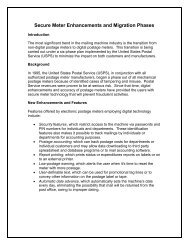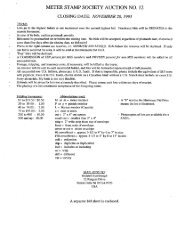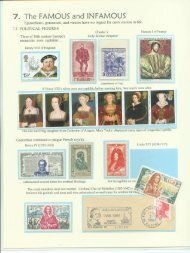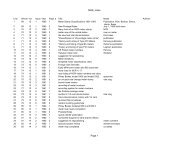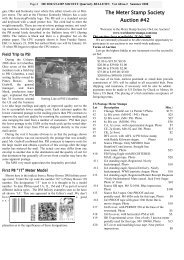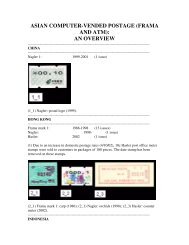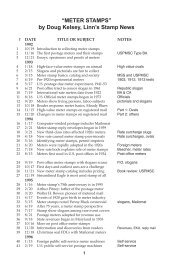GB Meter Franking - The Meter Stamp Society
GB Meter Franking - The Meter Stamp Society
GB Meter Franking - The Meter Stamp Society
You also want an ePaper? Increase the reach of your titles
YUMPU automatically turns print PDFs into web optimized ePapers that Google loves.
BRITISH STAMPS<br />
Fig 114 (top) Label from the modified Simplex Major machine of Draffens of<br />
Dundee<br />
Fig 115 (above) Specimen label from Draffens’ second machine, numbered<br />
SL2, on tape intended for the multivalue machine<br />
Fig 116 (below) A label anticipating foreign sales of the Simplex<br />
MacRobertson & Hutchinson of Glasgow,<br />
was issued posthumously with a George VI<br />
Group D frank die.<br />
Although the normal Simplex machines<br />
could not print on to continuous paper<br />
tape, it has been mentioned that two<br />
machines were modified for the Post Office<br />
to produce parcel post labels. In 1955 a<br />
similarly modified Major model was sold<br />
to Draffens of Dundee Ltd. <strong>The</strong> values<br />
printed ranged from 1d. to 2s.1d. in steps<br />
of 1d. <strong>The</strong> prefix SL was allocated to this<br />
model.<br />
Fig 114 shows labels for this machine,<br />
numbered SL1. Initially, ‘SL1 DUNDEE<br />
ANGUS’ was printed continuously along<br />
the tape. Later, when the company acquired<br />
a second machine, the wording was<br />
changed to ‘DRAFFENS OF DUNDEE<br />
LTD. ANGUS’. <strong>The</strong> second machine,<br />
numbered SL2, was supplied in 1956. This<br />
was a Junior model with values from 1 ⁄2d. to<br />
1s. 1 ⁄2d. Some specimens from this machine<br />
were printed on tape intended for the<br />
multivalue machine UF 490 (Fig 115), later<br />
the normal DRAFFEN tape was used. Only<br />
two machines were sold in the UK but<br />
foreign sales were at least anticipated, as<br />
illustrated in Fig 116 for use in Singapore.<br />
By 1955 Langdon had developed a multivalue<br />
machine for Neopost. It was given<br />
the name ‘Frankmaster’ and the earliest<br />
model was available for commercial use<br />
in that year. <strong>The</strong> electrically-driven<br />
version is illustrated (Fig 117). As<br />
introduced, the machine was heavy<br />
and awkward to handle, bearing in<br />
mind that it had to be taken to a local<br />
post office for resetting. <strong>The</strong> features<br />
offered were the basic minimum.<br />
Nevertheless, it filled a major gap in<br />
the Neopost range. Development<br />
continued and a redesigned version<br />
called the Model 305 was launched<br />
in 1965. During the ‘E’ frank period,<br />
prefixes used were NA to ND. For each<br />
prefix, machine numbers ranged from 001<br />
to 999. <strong>The</strong>re were several versions of the<br />
Neopost 305 with either 3 or 4 operable<br />
banks. From the right of the frank, the first<br />
bank printed either ‘ 1 ⁄2’ or ‘=’, the second<br />
bank printed ‘=’ for the nil value, then ‘1’<br />
to ‘11’ (‘10’ and ‘11’ were printed as if<br />
single characters). <strong>The</strong> third bank used ‘0’<br />
for the nil value, then printed ‘1’ to ‘9’.<br />
<strong>The</strong> fourth bank again used ‘=’ as the nil<br />
value, then printed ‘1’ to ‘9’. Fig 118 shows<br />
how ‘2d.’ appeared. Fig 119 is a specimen,<br />
illustrating the maximum possible value<br />
from a four-bank machine and shows ‘11’<br />
as a single character. Fig 120 shows a frank<br />
on a piece of continuous tape.<br />
As with the Simplex, one machine,<br />
numbered NA 156, used by James H<br />
Lamont of Edinburgh, was fitted with a G<br />
VI R Group D die posthumously. It would<br />
appear that the machine was originally<br />
supplied with an EIIR die. It has been<br />
suggested that the user requested a G VI R<br />
die for patriotic reasons!<br />
At Universal Postal Frankers their design<br />
team had been commissioned to redesign<br />
the multivalue machine. <strong>The</strong> new version<br />
was launched in 1958 with the name<br />
‘Automax’.<br />
Three-bank machines had the value<br />
range 1 ⁄2d. to 9s.11 1 ⁄2d. and four-bank either<br />
1<br />
⁄2d. to 29s.11 1 ⁄2d. or 1 ⁄2d. to 99s.11 1 ⁄2d.<br />
Hand-driven models could print up to<br />
40 items/minute and electrically-driven<br />
models up to 80 items/minute. <strong>The</strong> earliest<br />
recorded date for commercial use was 12<br />
November 1958, although Specimens with<br />
earlier dates are known (Fig 121).<br />
<strong>The</strong> prefixes used with Group E franks<br />
were A and AA, each prefix catered for<br />
numbers from 001 to 999. Fig 122 illustrates<br />
each of the prefixes. Some early<br />
machines had a small ‘=’ sign as the nil<br />
value in the first bank, also shown.<br />
Fig 118 A frank from the Neopost 305<br />
Fig 117 <strong>The</strong><br />
electricallydriven<br />
version<br />
of the<br />
Neopost<br />
Frankmaster<br />
24 G.S.M. October 2001





